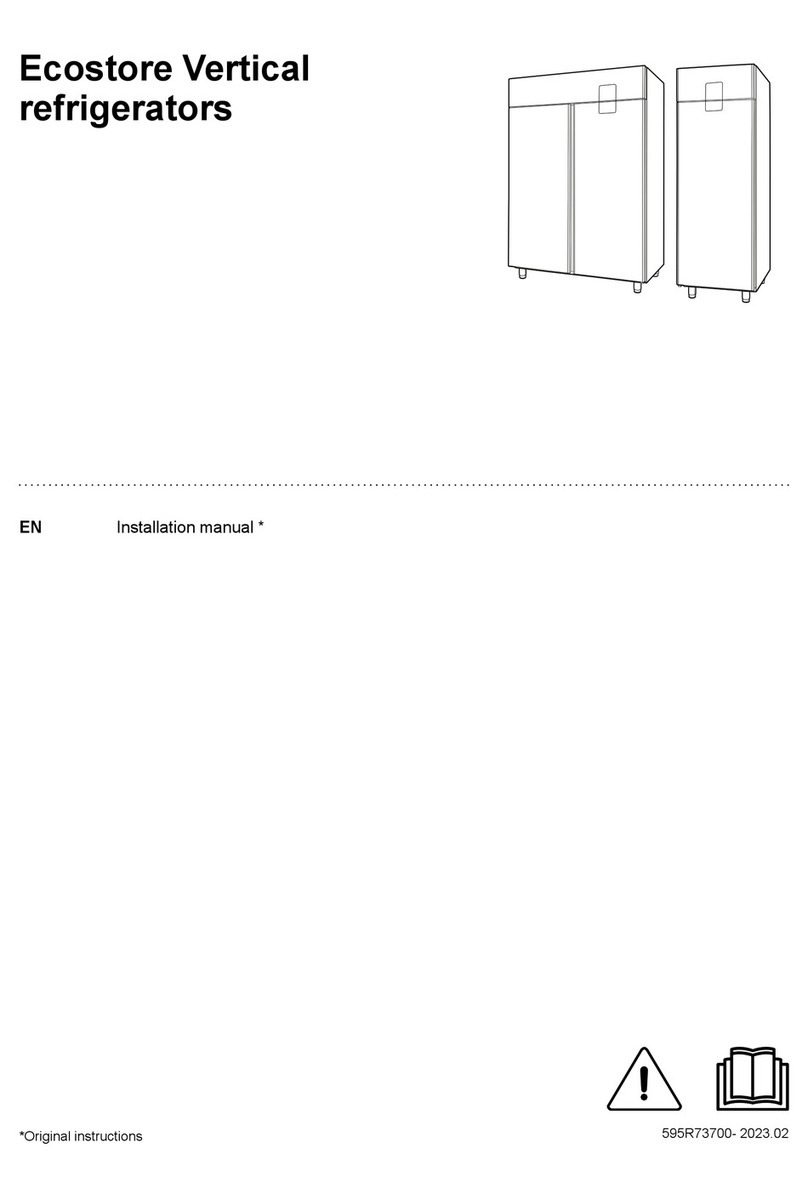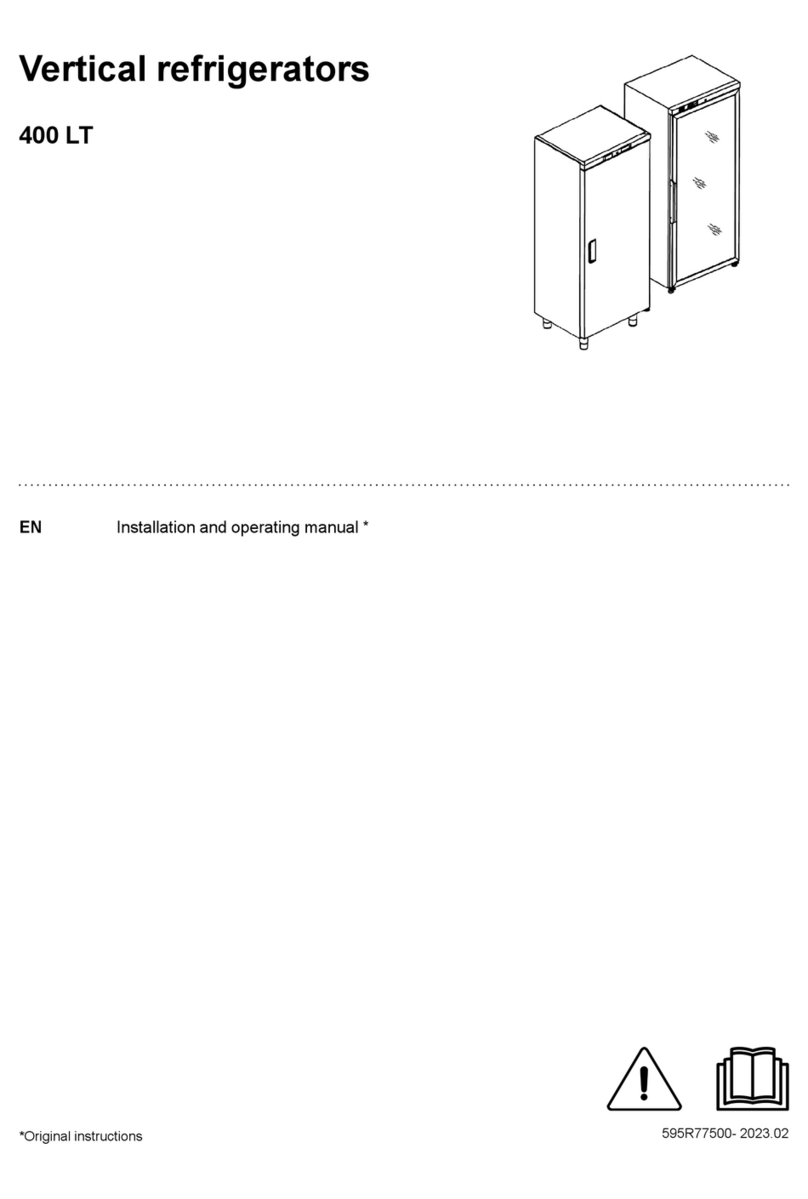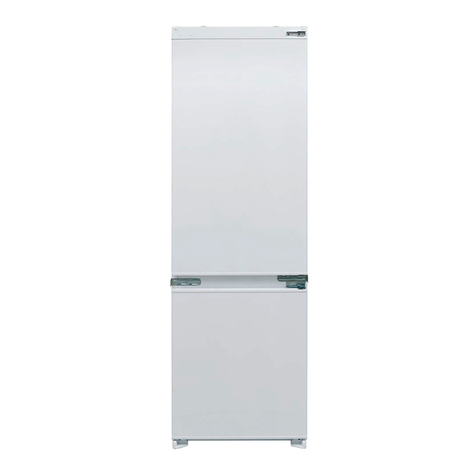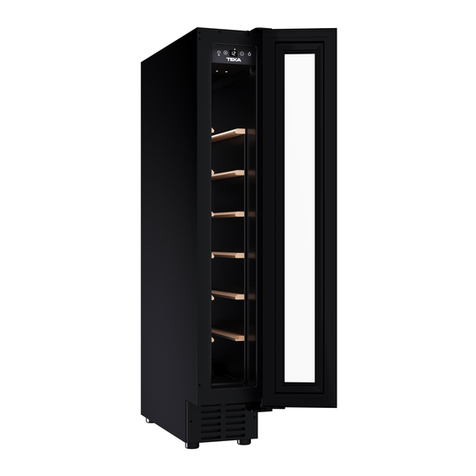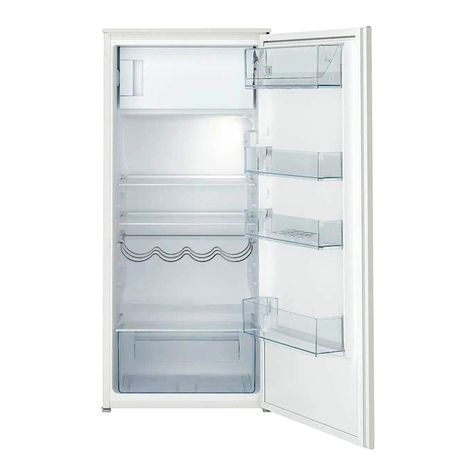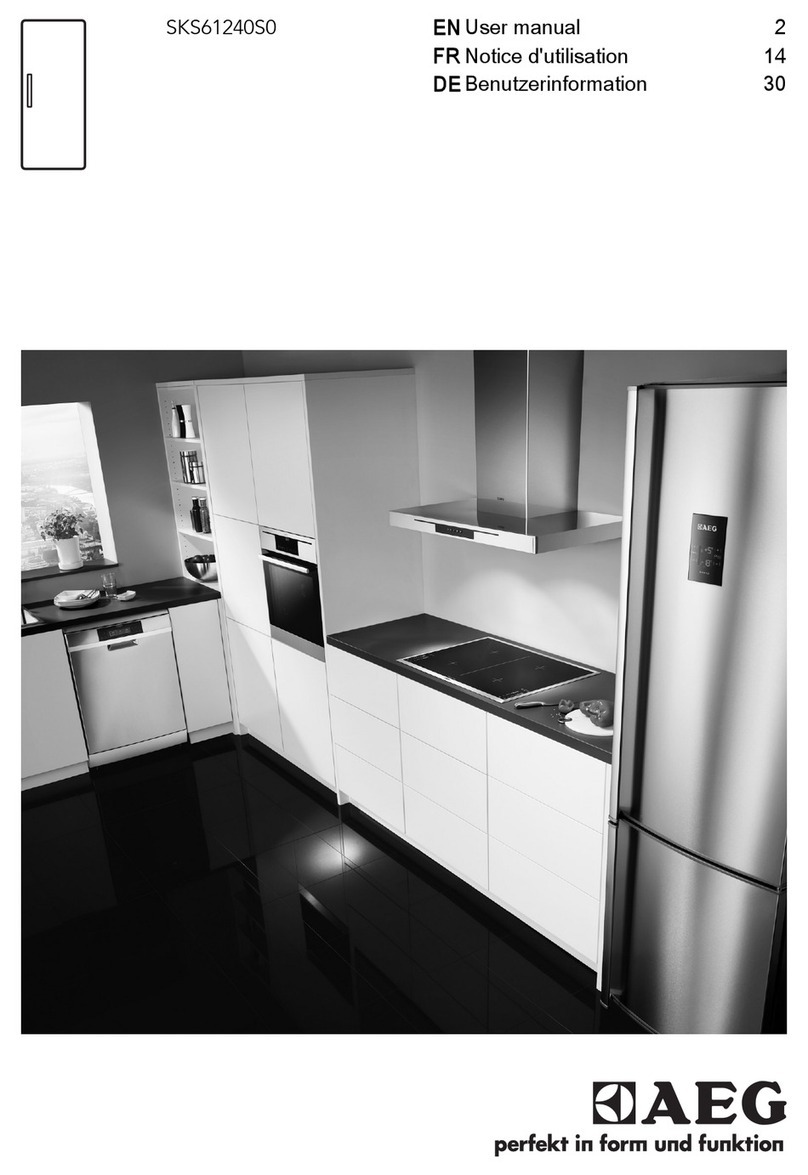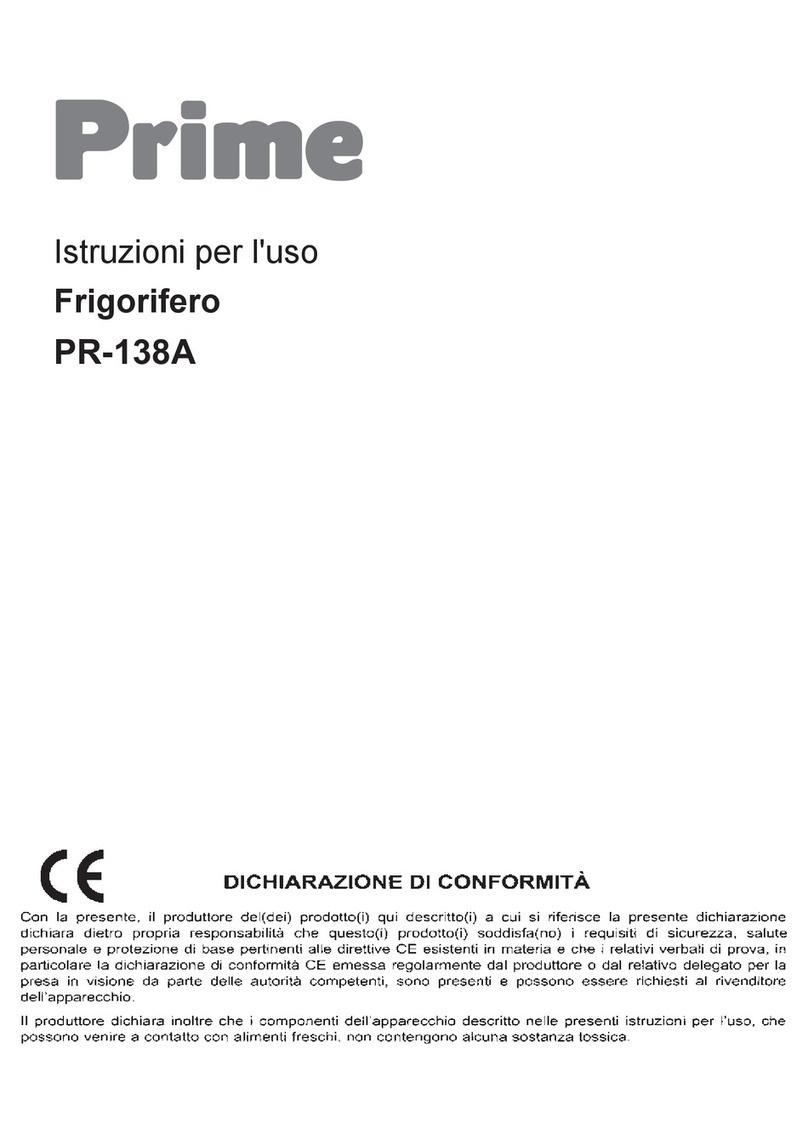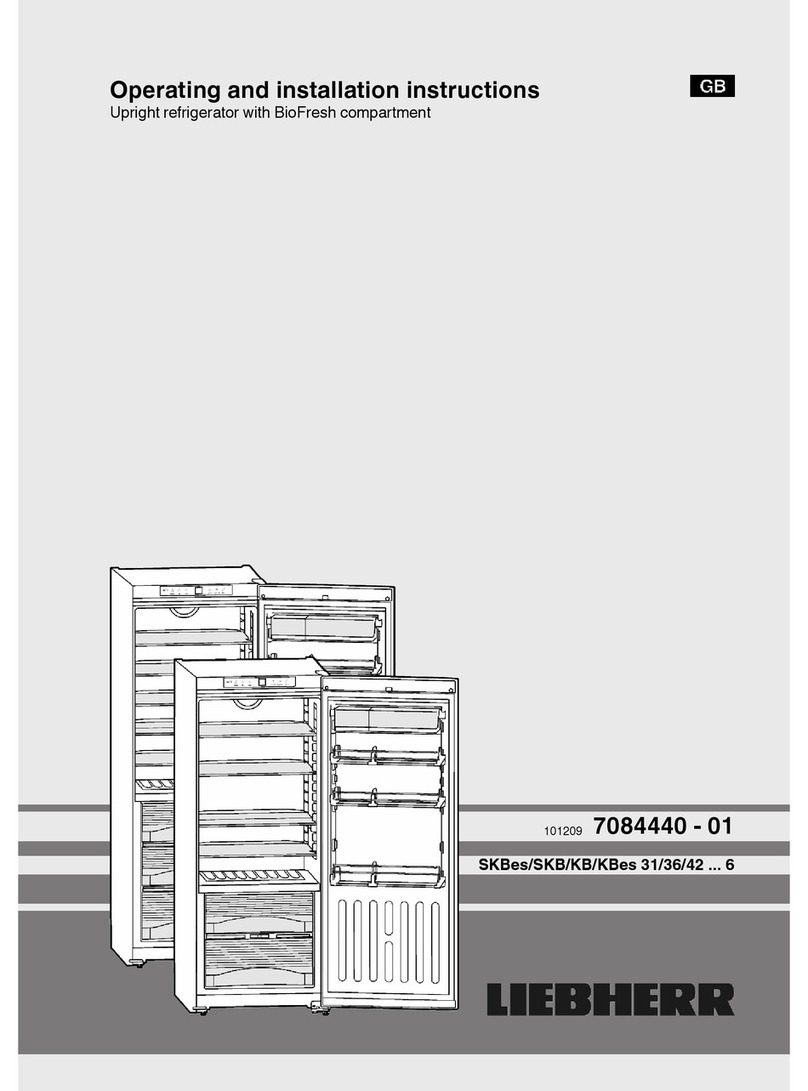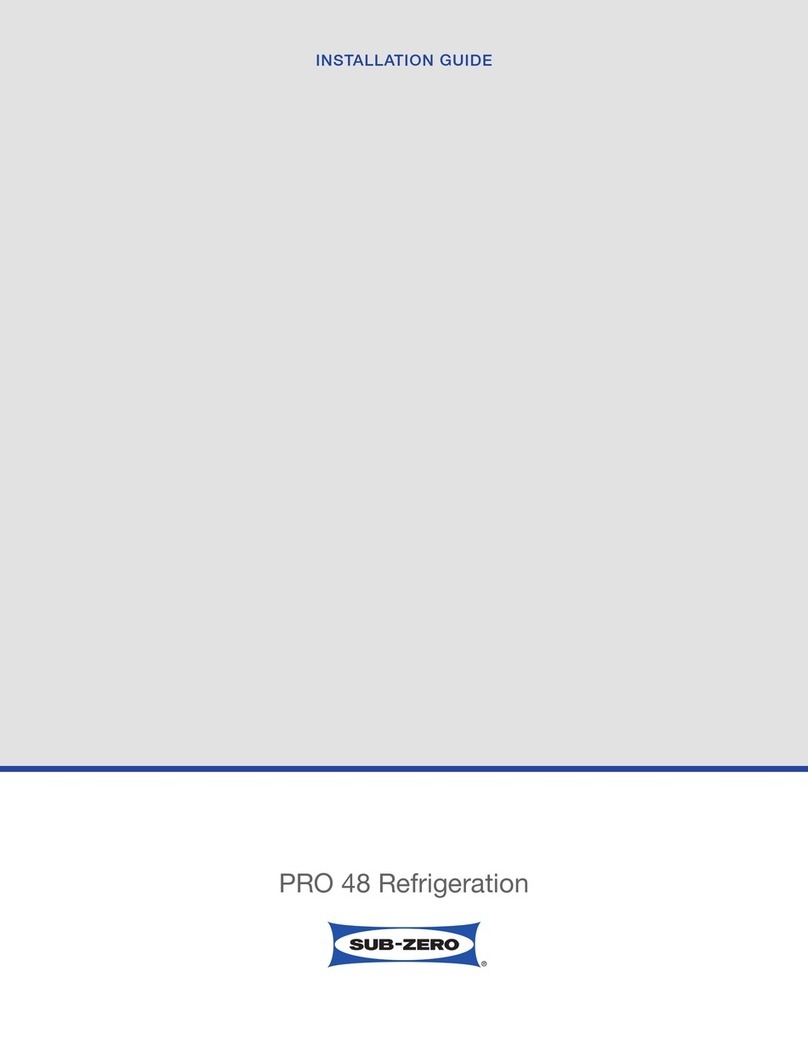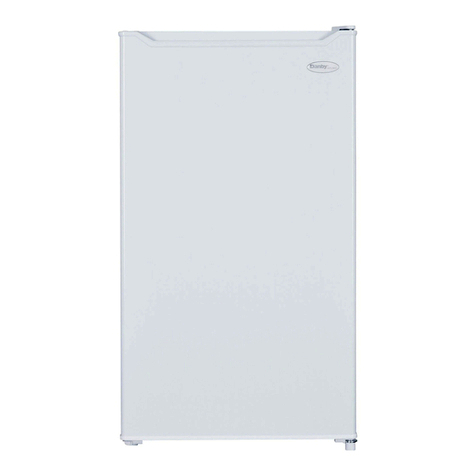Electrolux Professional Ecostore Series User manual

Ecostore Vertical
refrigerators
EN User manual *
*Original instructions 595R73800- 2022.09

2
Foreword
Read the following instructions, including the warranty terms before installing and using the appliance.
Visit our website www.electroluxprofessional.com and open the Support section to:
Register your product
Get hints & tips of your product, service and repair information
The installation, use and maintenance manual (hereinafter Manual) provides the user with information necessary for correct and
safe use of the appliance.
The following must not be considered a long and exacting list of warnings, but rather a set of instructions suitable for improving ap-
pliance performance in every respect and, above all, preventing injury to persons and animals and damage to property due to im-
proper operating procedures.
All persons involved in appliance transport, installation, commissioning, use and maintenance, repair and disassembly must con-
sult and carefully read this manual before carrying out the various operations, in order to avoid wrong and improper actions that
could compromise the appliance's integrity or endanger people. Make sure to periodically inform the user regarding the safety reg-
ulations. It is also important to instruct and update personnel authorised to operate on the appliance, regarding its use and
maintenance.
The manual must be available to operators and carefully kept in the place where the appliance is used, so that it is always at hand
for consultation in case of doubts or whenever required.
If, after reading this manual, there are still doubts regarding appliance use, do not hesitate to contact the Manufacturer or the au-
thorised Service Centre to receive prompt and precise assistance for better operation and maximum efficiency of the appliance.
During all stages of appliance use, always respect the current regulations on safety, work hygiene and environmental protection. It
is the user's responsibility to make sure the appliance is started and operated only in optimum conditions of safety for people, ani-
mals and property.
IMPORTANT
• The manufacturer declines any liability for operations carried out on the appliance without respecting the instructions
given in this manual.
• The manufacturer reserves the right to modify the appliances presented in this publication without notice.
• No part of this manual may be reproduced.
• This manual is available in digital format by:
– contacting the dealer or reference customer care;
– downloading the latest and up to date manual on the web site www.electroluxprofessional.com;
• The manual must always be kept in an easily accessed place near the appliance. Appliance operators and mainte-
nance personnel must be able to easily find and consult it at any time.

3
Contents
A WARNING AND SAFETY INFORMATION...................................................................................................4
A.1 General information ......................................................................................................................4
A.2 Personal protection equipment ........................................................................................................4
A.3 General safety .............................................................................................................................5
A.4 Protection devices installed on the appliance ...................................................................................... 5
A.5 Safety signs to be placed on the appliance or near its area ....................................................................6
A.6 Reasonably foreseeable improper use ..............................................................................................6
A.7 Residual risks ..............................................................................................................................6
A.8 Product loading and unloading ........................................................................................................ 7
A.9 Maximum load .............................................................................................................................7
A.10 Appliance cleaning........................................................................................................................7
A.11 Cleaning the cabinet and accessories ............................................................................................... 7
A.12 Preventive Maintenance.................................................................................................................7
A.13 Parts and accessories ...................................................................................................................7
A.14 Precautions for use and maintenance ............................................................................................... 7
A.15 Appliance maintenance..................................................................................................................8
A.16 Maintenance intervals....................................................................................................................8
B APPLIANCE AND MANUFACTURER'S IDENTIFICATION DATA .....................................................................8
C WARRANTY .........................................................................................................................................9
C.1 Warranty terms and exclusions........................................................................................................ 9
D GENERAL INFORMATION ......................................................................................................................9
D.1 Introduction.................................................................................................................................9
D.2 Intended use and restrictions .......................................................................................................... 9
D.3 Testing and inspection ...................................................................................................................9
D.4 Copyright....................................................................................................................................9
D.5 Keeping the manual ......................................................................................................................9
D.6 Recipients of the manual .............................................................................................................. 10
D.7 Definitions................................................................................................................................. 10
D.8 Responsibility ............................................................................................................................ 10
E NORMAL MACHINE USE...................................................................................................................... 10
E.1 Characteristics of personnel enabled to operate on the appliance ......................................................... 10
E.2 Basic requirements for appliance use.............................................................................................. 10
F OPERATING....................................................................................................................................... 11
F.1 Description of the control panel...................................................................................................... 11
G INSTRUCTION FOR THE USER............................................................................................................. 11
G.1 Switching on the appliance ........................................................................................................... 11
G.2 Setting the temperature ............................................................................................................... 11
G.3 Signalling icons.......................................................................................................................... 12
G.4 Alarms and signalling .................................................................................................................. 12
G.5 Defrost ..................................................................................................................................... 12
G.6 Internal light .............................................................................................................................. 12
G.7 Loading the product .................................................................................................................... 12
H MACHINE CLEANING AND MAINTENANCE............................................................................................. 12
H.1 Ordinary maintenance ................................................................................................................. 12
H.1.1 Care information ............................................................................................................... 12
H.1.2 Cleaning introduction ......................................................................................................... 13
H.1.3 Compartment cleaning ....................................................................................................... 13
H.1.4 Periods of non-use ............................................................................................................ 13
I TROUBLESHOOTING.......................................................................................................................... 13
I.1 Introduction ............................................................................................................................... 13
I.2 Troubleshooting ......................................................................................................................... 13

4
A WARNING AND SAFETY INFORMATION
A.1 General information
To ensure safe use of the appliance and a proper understanding of the manual it is necessary to be familiar with the terms and
typographical conventions used in the documentation. The following symbols are used in the manual to indicate and identify the
various types of hazards:
WARNING
Danger for the health and safety of operators.
WARNING
Danger of electrocution - dangerous voltage.
CAUTION
Risk of damage to the appliance or the product.
WARNING
Risk of fire / Flammable materials
Pressure
IMPORTANT
Important instructions or information on the product
Read the instructions before using the appliance
Clarifications and explanations
• Only specialised personnel are authorised to operate on the appliance.
• This appliance is not intended for use by persons (including children) with reduced physical, sensor or mental capabilities, or lack
of experience and knowledge, unless they have been given supervision or instruction concerning use of appliance by a person
responsible for their safety.
• Do not let children play with the appliance.
• Keep all packaging and detergents away from children.
• Cleaning and user maintenance shall not be made by children without supervision.
• For your safety do not store or use gasoline or other flammable materials, vapours and liquids in the vicinity of this or any other
appliance.
• Do not store explosive substances, such as pressurized containers with flammable propellant, in this appliance.
• Refer to the data given on the appliance’s data plate for relations with the Manufacturer (e.g. when ordering spare parts, etc.).
• When scrapping the appliance, the marking must be destroyed.
• Save these instructions carefully for further consultation by the various operators.
A.2 Personal protection equipment
Summary table of the Personal Protection Equipment (PPE) to be used during the various stages of the machine's service life.
Stage Protective
garments
Safety footwear Gloves Glasses Safety helmet
Transport —● ○ —○
Handling ● ○ — —
Unpacking ●— —
Installation ●—
Normal use —
Routine cleaning —
Extraordinary cleaning ●—
Maintenance ●—

5
Stage Protective
garments
Safety footwear Gloves Glasses Safety helmet
Dismantling ●—
Scrapping ●—
Key:
●PPE REQUIRED
○PPE AVAILABLE OR TO BE USED IF NECESSARY
—PPE NOT REQUIRED
A.3 General safety
• The appliances are provided with electric and/or mechanical safety devices for protecting workers and the appliance itself.
• Never operate the appliance, removing, modifying or tampering with the guards, protection or safety devices.
• Do not make any modifications to the parts supplied with the appliance.
• Several illustrations in the manual show the appliance, or parts of it, without guards or with guards removed. This is purely for
explanatory purposes. Do not use the appliance without the guards or with the protection devices deactivated.
Disconnect the appliance from the power supply before
carrying out any installation, assembly, cleaning or
maintenance procedure.
• Do not remove, tamper with or make illegible the marking and safety, danger and instruction signs and labels on the appliance.
• The A-weighted emission sound pressure level does not exceed 70 dB(A).1
• Carefully avoid exposure of the equipment to ozone - do not use ozonizers in the rooms where the equipment is installed.
• The following operations have to be carried out by specialised authorised personnel or Customer Care Service provided with all
the appropriate personal protection equipment (A.2 Personal protection equipment), tools, utensils and ancillary means, who can
ask the manufacturer to supply a servicing manual:
– Installation and assembly
– Installation of the refrigerant fluid condensing unit
– Positioning
– Electrical connection
– Appliance cleaning, repair and extraordinary maintenance
– Appliance disposal
– Work on electrical equipment
– Dismantling operations of appliances which use R290 or R-744 (with a refrigeration system under high pressure)
– Dismantling operations of appliances which use flammable insulation blowing gases;
A.4 Protection devices installed on the appliance
Guards
The appliance has:
• fixed guards (e.g. casings, covers, side panels, etc.), fixed to the appliance and/or frame with screws or quick-release connectors
that can only be removed or opened with tools; therefore the user must not remove or tamper with such devices. The
Manufacturer declines any liability for damage due to tampering or their non-use;
• interlocked movable guards (door) for access inside the appliance;
• appliance electrical equipment access panels or doors, made from hinged panels openable with tools. The panel or the door
must not be opened when the appliance is connected to the power supply.
ON
OFF
1. The noise emission values have been obtained according to EN ISO 11204. The value could increase depending on the workplace where
measured.

6
A.5 Safety signs to be placed on the appliance or near its area
Prohibition Meaning
do not remove the safety devices
do not use water to extinguish fires (placed on electrical parts)
Danger Meaning
caution hot surface
danger of electrocution (shown on electrical parts with indication of voltage)
A.6 Reasonably foreseeable improper use
Improper use is any use different from that specified in this manual. During appliance operation, other types of work or activities
deemed improper and that in general can involve risks for the safety of operators and damage to the appliance are not allowed.
Reasonably foreseeable improper use includes:
• lack of appliance maintenance, cleaning and periodical checks;
• structural changes or modifications to the operating logic;
• tampering with the guards or safety devices;
• failure to use personal protection equipment by operators, specialised personnel and maintenance personnel;
• failure to use suitable accessories (e.g. use of unsuitable equipment or ladders);
• keeping combustible or flammable materials, or in any case materials not compatible with or pertinent to the work, near the
appliance;
• wrong appliance installation;
• placing in the appliance any objects or things not compatible with its use, or that can damage the appliance, cause injury or
pollute the environment;
• climbing on the appliance;
• non-compliance with the requirements for correct appliance use;
• other actions that give rise to risks not eliminable by the Manufacturer.
• failure to insure complete closure of doors or drawers, through forgetfulness or carelessness
• place the product in the compartments so as to block proper air circulation or hinder the perfect closing of doors / drawers
• exceed product weight allowed for each shelf / drawer
A.7 Residual risks
The appliance has several risks that were not completely eliminated from a design standpoint or with the installation of adequate
protection devices. Nevertheless, through this manual the Manufacturer has taken steps to inform operators of such risks, carefully
indicating the personal protection equipment to be used by them. In order to reduce the risks, provide for sufficient spaces while
installing the unit.
To preserve these conditions, the areas around the appliance must always be:
• kept free of obstacles (e.g. ladders, tools, containers, boxes, etc.);
• clean and dry;
• well lit.
For the Customer's complete information, the residual risks remaining on the appliance are indicated below: such actions are
deemed improper and therefore strictly forbidden.
Residual risk Description of hazardous situation
Slipping or falling The operator can slip due to water, any liquid or dirt on the floor
Burns/abrasions (e.g. heating elements, cold
pan, cooling circuit plates and pipes)
The operator deliberately or unintentionally touches some components
inside the appliance without using protective gloves.
Electrocution Contact with live parts during maintenance operations carried out with the
electrical panel powered
Falling from above The operator intervenes on the appliance using unsuitable systems to
access the upper part (e.g. rung ladders, or climbs on it)
Crushing or injury The specialised personnel may not correctly fix the control panel when
accessing the technical compartment. The panel could close suddenly.

7
Residual risk Description of hazardous situation
Tipping of loads When handling the appliance or the packing containing it, using unsuitable
lifting systems or accessories or with the unbalanced load
Chemical (refrigerant gas) Inhalation of refrigerant gas. Therefore always refer to the appliance labels
Sudden closure The operator for normal appliance use could suddenly and deliberately
close the door/drawers (if present, depending on the appliance type).
A.8 Product loading and unloading
• Cover or wrap food before placing it in the refrigerator and avoid putting very hot foods or steaming liquids inside.
• Do not use spray products for defrosting; in fact, they can be harmful to the health and/or damage the materials the appliance is
made from.
WARNING:
• Do not use mechanical devices or other means to speed up the defrost process, unless recommended by the manufacturer.
• Do not damage the refrigerant circuit.
• Do not use electrical appliances inside the appliance compartments for storing frozen food, unless such equipment is
recommended by the manufacturer.
• Keep the ventilation openings in the appliance casing free of any obstructions.
A.9 Maximum load
Regarding the maximum load for each appliance and each shelf, respect that given in the table below:
SHELF MAXIMUM LOAD 40 KG
A.10 Appliance cleaning
• Do not touch the appliance with wet hands or feet or when barefoot.
• Use a ladder with suitable protection for work on appliances with high accessibility.
• Put the appliance in safe conditions before starting any cleaning operation.
• Respect the requirements for the various routine and extraordinary maintenance operations. Non-compliance with the
instructions can create risks for personnel.
• Do not spray water or use water jets, steam cleaner or high pressure cleaner.
A.11 Cleaning the cabinet and accessories
• Pay attention to the selection and use of cleaning products in order to maintain proper appliance performance and safeness.
• Before using the appliance, clean all the internal parts and accessories with lukewarm water and neutral soap, or products that
are over 90% biodegradable (in order to reduce the emission of pollutants into the environment), then rinse and dry thoroughly,
where possible clean with dishwashing machine.
• Do not clean the appliance with detergents containing chlorine, solvent-based cleaning products (e. g. trichloro-ethylene),
abrasive powders or agents, scouring pads or sponges that could damage the surfaces. Do not use organic solvent substances
or essential oils. These substances could damage the parts of the appliance made from synthetic material.
• Do not use products (even if diluted) containing chlorine (sodium hypochlorite, hydrochloric or muriatic acid, etc.) to clean the
floor under the appliance.
A.12 Preventive Maintenance
In order to ensure the safety and performance of your equipment, it is recommended that service is undertaken by Electrolux
Professional authorised engineers every 12 months, in accordance with Electrolux Professional Service Manuals. Please contact
your local Electrolux Professional Service Centre for further details.
A.13 Parts and accessories
Use only original accessories and/or spare parts. Failure to use original accessories and/or spare parts will invalidate the original
manufacturer warranty and may render the appliance not compliant with the safety standard.
A.14 Precautions for use and maintenance
• Risks mainly of a mechanical, thermal and electrical nature exist in the appliance. Where possible the risks have been
neutralised:
– directly, by means of adequate design solutions.
– indirectly by using guards, protection and safety devices.
• Any anomalous situations are signalled on the control panel display.
• During maintenance several risks remain, as these could not be eliminated, and must be neutralised by adopting specific
measures and precautions.
• Do not carry out any checking, cleaning, repair or maintenance operations on moving parts. Workers must be informed of this
prohibition by means of clearly visible signs.
• Make sure to periodically check correct operation of all the safety devices and the insulation of electrical cables, which must be
replaced if damaged.
In case of a significant anomaly (e.g. short circuits, wires coming out of the terminal block, motor breakdowns, worn electrical cable
sheathing, etc.) the operator for normal appliance use must:
• immediately deactivate the appliance.

8
A.15 Appliance maintenance
• The inspection and maintenance intervals depend on the actual appliance operating conditions and ambient conditions
(presence of dust, damp, etc.), therefore precise time intervals cannot be given. In any case, careful and periodical appliance
maintenance is advisable in order to minimise service interruptions.
• It is advisable to stipulate a preventive and scheduled maintenance contract with the Customer Care Service.
• Put the appliance in safe conditions before starting any maintenance operation.
• To guarantee appliance efficiency and correct operation, periodical maintenance must be carried out according to the
instructions given in the manual.
A.16 Maintenance intervals
It is advisable to carry out the checks with the frequency given in the following table:
Maintenance, inspections, checks and
cleaning
Frequency Responsability
Ordinary cleaning
• general cleaning of appliance and surrounding
area
• Daily • Operator
Mechanical protection devices
• check their condition and for any deformation,
loosening or removed parts
• Yearly • Service
Door frame and Gasket
• Check the integrity status of the door frame
and door gasket.
Check the cleanliness of the door frame and
door gasket.
Replace in case broken.
• Monthly • Operator
Control
• check the mechanical parts, for cracks or
deformations, tightening of screws: check the
readability and condition of words, stickers
and symbols and restore if necessary
• Yearly • Service
Appliance structure
• tightening of main bolts (screws, fixing
systems, etc.) of appliance
• Yearly • Service
Safety signs
• check the readability and condition of safety
signs
• Yearly • Service
Electrical control panel
• check the electrical components installed
inside the electrical control panel. Check the
wiring between the electrical panel and
appliance parts
• Yearly • Service
Electrical connection cable
• check the connection cable (replace if
necessary)
• Yearly • Service
General appliance overhaul
• check all components, electrical equipment,
corrosion, pipes…
Every 10 years1• Service
1. The appliance is designed and built for a duration of about 10 years. After this period of time (from commissioning) the appliance must undergo a general
inspection and overhaul.
B APPLIANCE AND MANUFACTURER'S IDENTIFICATION DATA
The data plate gives the product identification and technical
data.
An example of the marking or data plate on the appliance is
given below:
The meaning of the various information given on it is listed
below:
F.Mod. factory description of product
Comm.Mod. commercial description
PNC production number code
Ser.No. serial number
Type ref. certification group of the appliance
Cyclopentane expanding gas used in insulation
V power supply voltage
Hz power supply frequency
Potenza Sbrinamento / Defrost Power xxx kW
x kWResistenza Evaporazione / Evaporation Heater El.
x WIlluminazione / Lihtin
Classe / Class x GWP xxxx CO2-eq xxx t
xx KRefrierante / Refrierant xxxxx
Cap. x
IPxx
Electrolux Professional SPA - Viale Treviso, 15 - 33170 Pordenone (Italy)
2019
Volt xxxx xxx xx Hz
Ser.Nr. xxxxxxxx
Comm.Model xxxxxxxxx Type ref. xxxxxxF.Mod. xxxxxxxxx
PNC 9VTX xxxxxxxx
W Tot. xxx kW
Cyclopentane
Total Current xx A

9
kW power input
A absorbed current
Evaporation
heater El.
evaporation heating element power
Class climatic class
GWP global warming potential
CO2 eq quantity of greenhouse gases
Lighting internal light
Cap. nominal capacity
Refrigerant type of refrigerant gas
Defrost power current absorbed
CE marking
WEEE symbol
IP21 dust and water protection rating
C WARRANTY
C.1 Warranty terms and exclusions
If the purchase of this product includes warranty coverage,
warranty is provided in line with local regulations and subject to
the product being installed and used for the purposes as
designed, and as described within the appropriate equipment
documentation.
Warranty will be applicable where the customer has used only
genuine spare parts and has performed maintenance in
accordance with Electrolux Professional user and mainte-
nance documentation made available in paper or electronic
format.
Electrolux Professional strongly recommends using Electrolux
Professional approved cleaning, rinse and descaling agents to
obtain optimal results and maintain product efficiency over
time.
The Electrolux Professional warranty does not cover:
• service trips cost to deliver and pick up the product;
• installation;
• training on how to use/operate;
• replacement (and/or supply) of wear and tear parts unless
resulting from defects in materials or workmanship reported
within one (1) week from the failure;
• correction of external wiring;
• correction of unauthorized repairs as well as any damages,
failures and inefficiencies caused by and/or resulting from;
– insufficient and/or abnormal capacity of the electrical
systems (current/voltage/frequency, including spikes and/or
outages);
– inadequate or interrupted water supply, steam, air, gas
(including impurities and/or other that does not comply with
the technical requirements for each appliance);
– plumbing parts, components or consumable cleaning
products that are not approved by the manufacturer;
– customer’s negligence, misuse, abuse and/or non-com-
pliance with the use and care instructions detailed within the
appropriate equipment documentation;
– improper or poor: installation, repair, maintenance
(including tampering, modifications and repairs carried out
by third parties not authorized) and modification of safety
systems;
– Use of non-original components (e. g.: consumables,
wear and tear, or spare parts);
– environment conditions provoking thermal (e. g. over-
heating/freezing) or chemical (e. g. corrosion/oxidation)
stress;
– foreign objects placed in- or connected to- the product;
– accidents or force majeure;
– transportation and handling, including scratches, dents,
chips, and/or other damage to the finish of the product,
unless such damage results from defects in materials or
workmanship and is reported within one (1) week of delivery
unless otherwise agreed;
• product with original serial numbers that have been
removed, altered or cannot be readily determined;
• replacement of light bulbs, filters or any consumable parts;
• any accessories and software not approved or specified by
Electrolux Professional.
Warranty does not include scheduled maintenance activities
(including the parts required for it) or the supply of cleaning
agents unless specifically covered within any local agreement,
subject to local terms and conditions.
Check on Electrolux Professional website the list of authorized
customer care.
D GENERAL INFORMATION
WARNING
Refer to “Warning and Safety
Information“.
D.1 Introduction
This manual contains information relevant to various applian-
ces. The product images in this guide are only an example.
The drawings and diagrams given in the manual are not in
scale. They supplement the written information with an outline,
but are not intended to be a detailed representation of the
appliance supplied.
The numerical values given on the appliance installation
diagrams refer to measurements in millimeters and/or inches.
D.2 Intended use and restrictions
This appliance is designed for the refrigeration and preserva-
tion of foods.
Any other use is deemed improper.
NOTE!
The manufacturer declines any liability for
improper use of the product.
D.3 Testing and inspection
Our appliances have been designed and optimized, with
laboratory testing, in order to obtain high performance and
efficiency.
The appliance is shipped ready for use.
Passing of the tests (visual inspection - electrical test -
functional test) is guaranteed and certified by the specific
enclosures.
D.4 Copyright
This manual is intended solely for consultation by the operator
and can only be given to third parties with the permission of
Electrolux Professional company.
D.5 Keeping the manual
The manual must be carefully kept for the entire life of the
appliance, until scrapping. The manual must stay with the

10
appliance in case of transfer, sale, hire, granting of use or
leasing.
D.6 Recipients of the manual
This manual is intended for:
• the employer of appliance users and the workplace
manager;
• operators for normal appliance use;
• specialised personnel - Customer Care service (see service
manual).
D.7 Definitions
Listed below are the definitions of the main terms used in the
manual. It is advisable to read them carefully before use.
Operator appliance installation, adjustment, use,
maintenance, cleaning, repair and trans-
port personnel.
Manufacturer Electrolux Professional SpA or any other
service centre authorised by Electrolux
Professional SpA.
Operator for
normal appli-
ance use
an operator who has been informed and
trained regarding the tasks and hazards
involved in normal appliance use.
Customer
Care service
or specialised
personnel
an operator instructed/trained by the
Manufacturer and who, based on his
professional and specific training, experi-
ence and knowledge of the accident-
prevention regulations, is able to appraise
the operations to be carried out on the
appliance and recognise and prevent any
risks. His professionalism covers the
mechanical, electrotechnical and elec-
tronics fields etc.
Danger source of possible injury or harm to health.
Hazardous
situation
any situation where an operator is
exposed to one or more hazards.
Risk a combination of probabilities and risks of
injury or harm to health in a hazardous
situation.
Protection
devices
safety measures consisting of the use of
specific technical means (guards and
safety devices) for protecting operators
against risks.
Guard an element of a appliance used in a
specific way to provide protection by
means of a physical barrier.
Safety device a device (other than a guard) that elimi-
nates or reduces the risk; it can be used
alone or in combination with a guard.
Customer the person who purchased the appliance
and/or who manages and uses it (e. g.
company, entrepreneur, firm).
Electrocution an accidental discharge of electric current
on a human body.
D.8 Responsibility
The Manufacturer declines any liability for damage and
malfunctioning caused by:
• non-compliance with the instructions contained in this
manual;
• repairs not carried out in a workmanlike fashion, and
replacements with parts different from those specified in
the spare parts catalogue (the fitting and use of non-original
spare parts and accessories can negatively affect appliance
operation and invalidates the original manufacturer
warranty);
• operations carried out by non-specialised personnel;
• unauthorized modifications or operations;
• missing, lack or inadequate maintenance;
• improper appliance use;
• unforeseeable extraordinary events;
• use of the appliance by uninformed and / or untrained
personnel;
• non-application of the current provisions in the country of
use, concerning safety, hygiene and health in the workplace.
The Manufacturer declines any liability for damage caused by
arbitrary modifications and conversions carried out by the user
or the Customer.
The employer, workplace manager or service technician are
responsible for identifying and choosing adequate and suitable
personal protection equipment to be worn by operators, in
compliance with regulations in force in the country of use.
The Manufacturer declines any liability for inaccuracies con-
tained in the manual, if due to printing or translation errors.
Any supplements to the installation, use and maintenance
manual the Customer receives from the Manufacturer will form
an integral part of the manual and therefore must be kept
together with it.
E NORMAL MACHINE USE
E.1 Characteristics of personnel enabled to
operate on the appliance
The Customer must make sure the personnel for normal
appliance use are adequately trained and skilled in their duties.
The operator must:
• read and understand the manual;
• receive adequate training and instruction for their duties in
order to operate safely;
• receive specific training for correct appliance use.
IMPORTANT
The Customer must make sure his personnel have
understood the instructions received and in partic-
ular those regarding work hygiene and safety in use
of the appliance.
E.2 Basic requirements for appliance use
• Knowledge of the technology and specific experience in
operating the appliance.
• Adequate general basic education and technical knowledge
for reading and understanding the contents of the manual,
including correct interpretation of the drawings, signs and
pictograms.
• Sufficient technical knowledge for safely performing his
duties as specified in the manual.
• Knowledge of the regulations on work hygiene and safety.

11
F OPERATING
F.1 Description of the control panel
1INTERNAL LIGHT BUTTON (if present)
It allows to switch on/off the inside light.
2
CONTINUOUS CYCLE BUTTON
It allows to activate/deactivate the Continuous
cycle
3DEFROST CYCLE ACTIVATION ICON/BUTTON
4COMPRESSOR ON SIGNALLING ICON
5DISPLAY
6UNIT OF MEASURE ℃/℉
7
TEMPERATURE BUTTON / UP ARROW
It allows to access the Set point and increase the
values.
8
PROGRAM BUTTON
Pressed briefly It allows to save value;
Pressed for 3 seconds it allows to unlock keypad
and enter programming mode.
9
ON-OFF BUTTON / DOWN ARROW for
decreasing the values.
It allows to activate-deactivate the appliance
10 ALARM SIGNALLING ICON
11 COMPARTMENT FANS ON SIGNALLING ICON
G INSTRUCTION FOR THE USER
G.1 Switching on the appliance
Connect the power cable to a power socket. The instrument
display performs a Lamp Test and for a few seconds the
display shows the compressor icon flashes, until the compres-
sor starts.
To activate and deactivate the appliance touch Program button
for 3 seconds to unlock the display
and then touch ON/OFF button ;
The display will show the message ON (for activation) or
alternately the message OFF and the compartment temper-
ature (for deactivation).
Even if the machine is deactivated with the ON/OFF button it
still remains powered.
G.2 Setting the temperature
• Touch Program button for 3 seconds to unlock the display;
• Press the temperature button.
The display shows the SET POINT.
• Press the UP arrow or the DOWN arrow to
change the SET value,
• Touch Program button to confirm the change.
If no button is pressed for 20 seconds (TIME OUT), the digital
thermostat memorises the last set value and the normal
display is restored.
The temperature range is set from a minimum to a maximum,
according to the following values:
Min. setting = - 22℃
Max. setting = - 15℃
Min. setting = - 2℃
Max. setting = + 10℃
1
2
3
4
5
6
11
1011
14
7
8
9

12
Min. setting = + 2℃
Max. setting = + 10℃
Min. setting = 0℃
Max. setting = + 6℃
G.3 Signalling icons
lit up This icon indicates compressor
activation.
lit up This icon indicates defrost function in
progress.
lit up This icon indicates activation of com-
partment fans.
lit up This icon indicates that a alarm has
occurred during appliance operation.
G.4 Alarms and signalling
The alarm is signalled by lighting up of the Icon .
Alarm signalling is also indicated by the alarm code appearing
on the display (see section I.2 Troubleshooting).
Example: Alarm signalling due to a faulty probe (compartment
probe) appears directly on the instrument display with the
message E0 and rE flashing alternately.
Press any button to mute the buzzer.
When the alarm condition ceases, the alarm goes off.
Otherwise, contact the Customer Care Service.
G.5 Defrost
Automatic defrost
The appliance has an automatic defrost function. This function
is signalled by lighting up of the icon . The defrost water is
run into a tray and automatically evaporated.
Manual activation of defrost
• Touch Program button for 3 seconds to unlock the display;
• Press defrost button to start a manual defrost cycle.
Defrost can be stopped manually at any time by pressing again
the button ; the display shows the message dFE. Defrost
cannot be activated in the programming stage.
G.6 Internal light
If present the internal light button , it is possible to switch
on/off the inside light.
Unlock the display by touching the Program button for 3
seconds and then switch on/off the internal light.
G.7 Loading the product
WARNING
Cover or wrap food before plac-
ing it in the refrigerator and avoid
putting very hot foods or steam-
ing liquids inside.
Distribute the product evenly inside the compartment (away
from the door and back) to allow good air circulation. In case of
excessive product loading, the temperature remains uniform
thanks to the removable rear supports which act as an air
conveyor.
CAUTION
Do not place the product directly on
bottom. Use the specific provided rack.
Do not leave the door open any longer than necessary when
loading or removing food.
It is advisable to keep the keys in a place only accessible to
authorised personnel. To prevent unauthorised personnel from
opening the appliance, it is advisable to always close it with the
key.
H MACHINE CLEANING AND MAINTENANCE
WARNING
Refer to “Warning and Safety
Information“.
H.1 Ordinary maintenance
H.1.1 Care information
Care operations have to be carried out by the owner and/or
user of the appliance.

13
IMPORTANT
Problems resulting from poor or lack of care as
hereinafter described will not be covered by the
warranty.
H.1.2 Cleaning introduction
For detailed information regarding appliance cleaning refer to
paragraph A.11 Cleaning the cabinet and accessories.
H.1.3 Compartment cleaning
The racks can be removed in order to thoroughly clean the
compartment, therefore remove them before cleaning. For this,
use products that are over 90% biodegradable (do not use
solvents or abrasive powders), then rinse and dry thoroughly.
Lastly, remove the plug closing the drain hole (refrigerated
models only) and drain the water (only if it is connected, see
paragraph Plumbing connection in the complete installation
manual on the web-site).
CAUTION
There is an extra rack on the bottom of the
compartment. When cleaning, if this rack
is temporarily removed, remember to refit
it in its original place, as shown in the
figure (detail “c“), in order to ensure proper
operation of the appliance:
H.1.4 Periods of non-use
If the appliance is not going to be used for some time, take the
following precautions:
• disconnect the power supply or remove the plug from the
power socket, if present;
• carefully clean the internal parts of the appliance;
• remove all food from the compartment and clean the inside
and accessories;
• clean the cabinet, going over all the stainless steel surfaces
vigorously with a rag moistened with paraffin oil to create a
protective film;
• leave the door or drawers, if present, open so that air can
circulate inside, preventing the formation of unpleasant
odours;
• periodically air the premises.
I TROUBLESHOOTING
I.1 Introduction
Certain faults may occur during normal use of the appliance. In
some cases, faults can be eliminated easily and quickly by
following the indication below.
The display, if present, always shows a warning message or
alarm describing the occurring fault.
If the fault persists, contact the Customer Care Service:
1. Disconnect the appliance from the main power supply;
2. Switch off the safety circuit breaker ahead of the
appliance;
3. Remember to specify:
• the type of fault
• the appliance PNC (product number code)
• the Ser. No. (appliance serial number).
IMPORTANT
The appliance PNC and serial number are essential
for identifying the type of appliance and date of
manufacture.
The dataplate giving the product and technical data
is located inside the appliance. The plate giving the
appliance PNC code and serial number is located in
the unit compartment.
I.2 Troubleshooting
ANOMALY TYPE OF
ANOMALY DESCRIPTION POSSIBLE CAUSES ACTIONS
E0
rE ALARM Compartment
sensor fault
• Connector unplugged
• Probe and/or Probe wire
damaged
CALL SERVICE
HI WARNING Compartment high
temperature alarm
• Door left opened
• Excessive load
• Malfunctioning on the
cooling unit
If the problem persist Call
Service
a
b
c

14
LO WARNING Compartment low
temperature alarm
•
Malfunctioning on the
cooling unit
If the problem persist call
service
dor WARNING Door opened
• The door remained open
beyond the time limit set
whit the active cycle.
• Door closure recognition
system is failed.
• Ensure the appliance door is
closed and any physical
obstruction is not preventing
the door closure.
• If the problem persists even
with the door closed, Call
Service.
The appli-
ance does
not switch on.
— — — — — — — — • Electric supply issue
• Make sure the plug is prop-
erly inserted in power socket.
• Make sure the socket is
powered.
• check (if present) the suit-
ability of the fuse on the
plug; otherwise contact the
assistance service to replace
the fuse, which must have
the same characteristics as
the one being replaced.
• If the problem persists Call
Service.
The inside
temperature
is too high.
— — — — — — — —
• Door left open
• Issue with thermostat
setting
• Excessive load
• Heat source near the
appliance
• Make sure the doors close
properly.
• Check the thermostat setting.
• Make sure there is no heat
source near the appliance.
• Make sure the product is
correctly loaded.
• If the problem persists Call
Service.
The appli-
ance is too
noisy.
— — — — — — — — • Unit unlevelled or touch-
ing other equipment
• Make sure the appliance is
properly levelled. An unbal-
anced position can set off
vibrations.
• Make sure the appliance is
not touching other equip-
ment or parts which could
reverberate.
• If the problem persists Call
Service.


Electrolux Professional SPA
Viale Treviso 15
33170 Pordenone
www.electroluxprofessional.com
Other manuals for Ecostore Series
1
This manual suits for next models
11
Table of contents
Other Electrolux Professional Refrigerator manuals
